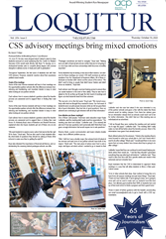 Justine DeFilippo
Justine DeFilippo
Students can now plagiarize easier than ever before. With multitudes of information, on any subject available on the Internet, the need for students to plow through mile-high stacks of encyclopedias is becoming obsolete. This wealth of information, however, has been leading students to cut corners and lift materials from various websites, otherwise known as plagiarizing.
Professors today face many more difficulties when it comes to catching plagiarism than they did 10 years ago. Dr. Margaret McGuinness, professor of religious studies and chair of the department said, “Before we could go to an encyclopedia or two and know within a few minutes if the student had plagiarized or not. Now, with so many options, it is becoming harder.” That does not mean that it is anywhere close to being impossible for a professor to catch plagiarism. Turnitin.com is a website devoted to comparing students papers against Internet materials to see if any matches come up. A professor can also log on to a search engine like Google.com, type in a sentence, hit the search key and within seconds any matching materials to that students work will appear. Mariana Peiretti, a first-year student at Cabrini, said, “I’m too afraid to get caught.” In this instance, fear could be a good thing.
With professors teaching multiple courses, time does not allow the professor to double check every paper for plagiarism. Professors need to rely mainly on instincts. John Heiberger, chair of the business department and associate professor, said, “If I see a level of work far superior to whatever I’ve seen from this student, that’s a red flag.”
Once a professor has gathered reasonable evidence that a student has plagiarized, they must go to the student first before any other actions occur.
As it stands now, there is a form that the teacher fills out stating the student’s name and the offense. That form now goes to the student to sign. The problem with the form, however, is that once the student signs the form he or she has admitted guilt to the accusation. Heiberger said that they are working on re-tooling the form so that it is no longer an admission of guilt but a statement letting the student know that they have been accused of plagiarism. The student can then either accept the charges or go before a committee to contest.
Penalties for plagiarism vary from professor to professor. “The student will receive an F for plagiarizing a paper,” McGuinness said. “If the plagiarism is extensive, the student may fail the course.” McGuinness does make clear that the long-term effects of plagiarism are not damaging to the student. “It just stays on file. Other teachers do not know,” McGuinness said. Heiberger agrees that a student’s anonymity is important for both the teacher and the student. “I start each semester with a clean slate towards each student. I think the information should remain private.” But Heiberger does believe that if the student is a chronic plagiarizer, the professor should know about it or the student should be asked to leave the college.
McGuinness thoroughly explains on the first day of class and in the syllabus that plagiarism will not be accepted. McGuinness, however, said that she comes across at least two cases of plagiarism each year. Plagiarism, though, is not always an intentional offense. “In some cases it’s more stupidity than intent to deceive,” Heiberger said. Heiberger also says that he strongly encourages research, just as long as the student cites the sources used. Senior Joe McCullough said, “I use other people’s work for ideas, but never word for word.” Senior Eric Dittler, an education major, agreed, “I use other papers for ideas. The library has examples that are helpful for coming up with lesson plans and things.” Heiberger says that if a student finds an idea he must expand on it, not paraphrase it.
The grounds for plagiarism differ from school to school. Cabrini does not incorporate an honor system, which mandates a zero tolerance policy for all wrong doings within the institution. Some honor systems require a student signature verifying that it is the student’s own original work and not an act of plagiarism. McGuinness said, “An honors system would be ideal, but it can’t happen overnight. It is something that would take years to initiate.”


